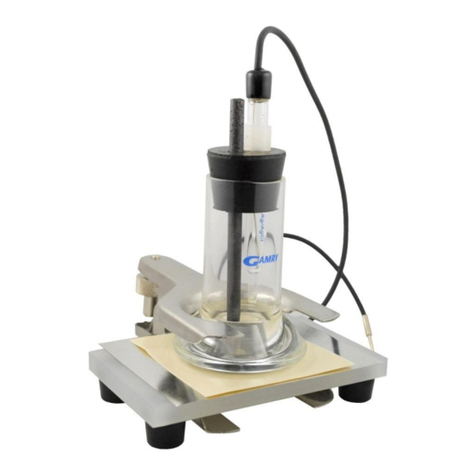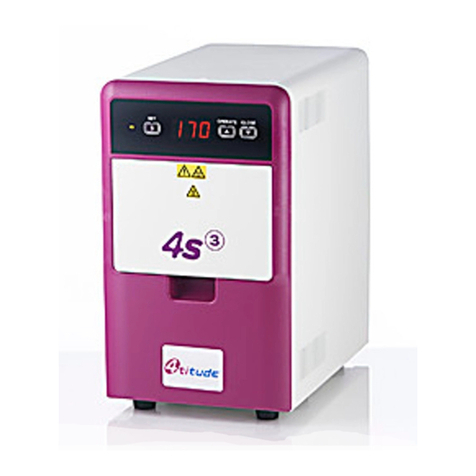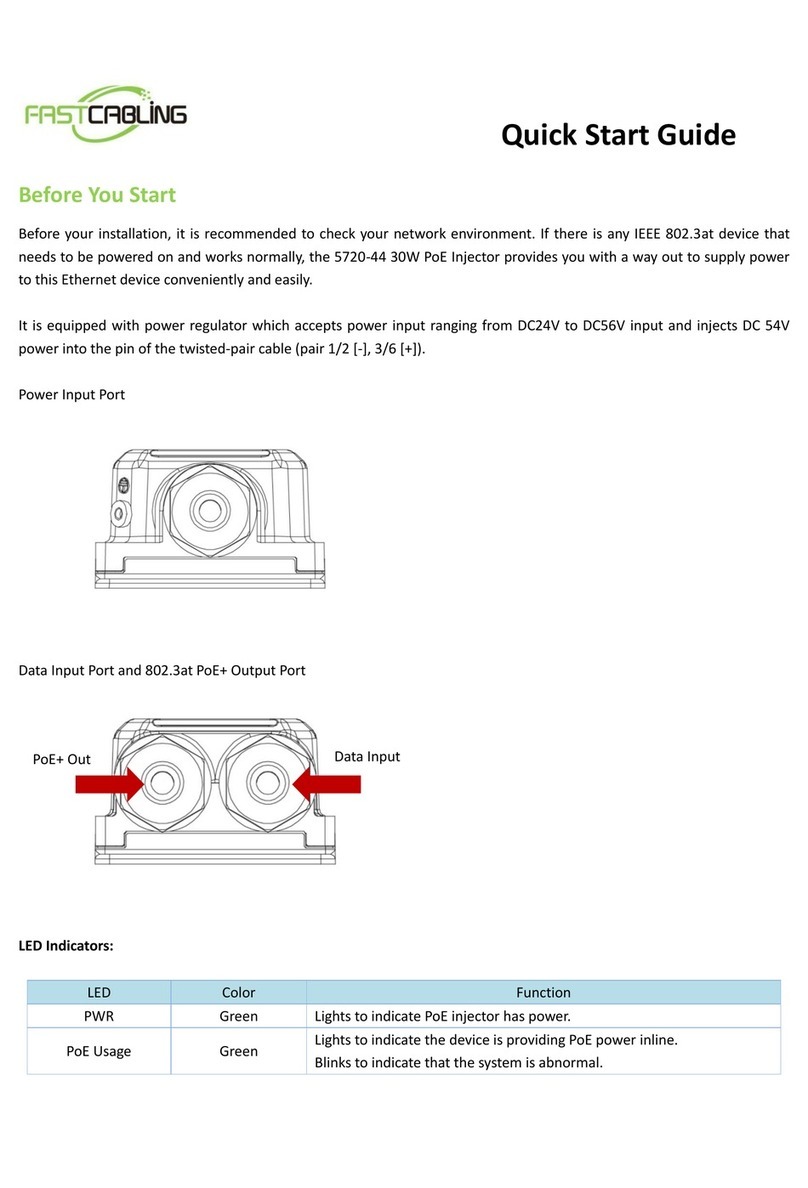NETZSCH LFA 447 Nanoflash User manual

Operating Instructions
LFA 447
TM
01/09 J:\LFA447\Contents.doc
Operating Instructions LFA 447TM Nanoflash
Contents
Chapter I General Information
Chapter II Installation
Chapter III System Components
Chapter IV Operating the Instrument
Chapter V Appendix

01/09 J:\LFA447\CHAPTER1.DOC
Chapter I
General Information
LFA 447
TM

General Information
LFA 447
TM
01/09 J:\LFA447\CHAPTER1.DOC 1
Information
In the design of your instrument, we endeavor to take individual
solutions into account and to include these in the documentation.
However, in order to keep the scope of the technical documentation at
a reasonable level, we must limit the description to a standard model.
We ask for your understanding, if additional information particular to
your instrument is not included within the scope of the standard
instructions.
This additional information can always be found on the corresponding
information sheets.
Prior written permission from NETZSCH-Gerätebau GmbH is required
for electronic or mechanical duplication and distribution of these
instructions.
All technical data, instrument features and other information described
in these operating instructions are presented to the best of our
knowledge and in accordance with the technical standards of the
instrument at the time of printing.
We welcome any comments, suggestions or new ideas concerning the
instrument and these operating instructions. Please address them to:
NETZSCH-Gerätebau GmbH
Wittelsbacherstraße 42
D - 95100 SELB
Telephone: 09287/881- 0
Telefax: 09287/881- 144
Internet: http://www.netzsch-thermal-analysis.com
Maintenance and service must be carried out by NETZSCH Customer
Service personnel.
A service contract is available for our customers.
This instruction manual is provided to give the customer information
on proper operation of the instrument. NETZSCH-Gerätebau GmbH will
accept no liability for damage resulting from improper use.

General Information
LFA 447
TM
01/09 J:\LFA447\CHAPTER1.DOC 2
Notes on the Use of this Manual
In this manual, the symbols described below are used to simplify orientation.
NOTE!
This sets particularly important information apart from the
rest of the text.
ATTENTION!
These instructions must be followed exactly to avoid injury
to the user and damage to the instrument.
This symbol refers to more detailed information which can
be found elsewhere, e.g. in the Software Manual.
The tools listed after this symbol are required for the
installation or modification of your instrument.

General Information
LFA 447
TM
01/09 J:\LFA447\CHAPTER1.DOC 3
Basic Safety Information
State-of-the-Art Your instrument has been produced with state-of-the-art
technology and is safe to operate.
Authorized
Operation
Any operation of the instrument other than as authorized
requires consultation with NETZSCH.
Any use exceeding the (expanded) authorized operation is
considered unauthorized. The manufacturer will not be liable
for any damage resulting from such use.
Manufacturer's
Requirements
Authorized operation of the instrument includes compliance
with manufacturer's requirements regarding installation,
commissioning, operation and maintenance.
Training of
Personnel
Your instrument may only be operated and maintained by
authorized, trained and individually instructed personnel who
have been informed of possible sources of danger.
Responsibility Responsibility for commissioning, operation and maintenance
must be clearly defined and compliance must be ensured. The
resulting responsibilities can be clearly resolved under the
aspect of safety.
Unauthorized Access
The operator must make sure that only trained personnel work
on the instrument.
Improper Operation Any type of operation which reduces the safety of the user and
the operability of the instrument should be avoided.
Unauthorized
Changes to the
System
Unauthorized modifications and changes which effect the
safety of the instrument are not permitted.
Obligation to Report
Changes to the
System
The user is obligated to immediately report to the operator in
charge any changes to the instrument which effect the safety of
the system.

General Information
LFA 447
TM
01/09 J:\LFA447\CHAPTER1.DOC 4
Maintenance
Obligation
The operator of the system must ensure that the instrument is
operated in perfect condition at all times.
Proper Set-up of the
Work Stations
The operator must guarantee the openness and cleanliness of
the work stations at the instrument through appropriate
instruction and inspections.
Shut-down For all maintenance work, the instrument must be switched off
and unplugged.
Removal of
Protective Devices
Protective devices may only be removed when the instrument is
switched off and unplugged. It is imperative that the
protective devices be replaced before starting the instrument.
Checks following
Maintenance or
Repair Work
After maintenance or repair work, a check should be made to
ensure that all protective devices are in place and operate
properly. Only then should the instrument be started.
Industry-specific
Accident Prevention
Regulations
The operator must observe the relevant regulations and
protective measures when handling the required gases. In
addition, possible reactions with the materials used must be
considered. At operating temperatures above 55°C, protective
gloves must be worn. In any case, the industry-specific and local
accident prevention regulations are also valid for the
instrument.
Disposal of
Production Materials
Production materials are to be disposed of according to local
regulations.
Maintenance or
Repair
Products sent in for maintenance or repair should, to the extent
possible, be free of harmful substances (e.g. radioactive, toxic,
caustic or microbiological materials). Otherwise, the type of
contamination must be declared. Products not explicitly
declared to be "free of harmful substances" will be
decontaminated at the expense of the sender.

General Information
LFA 447
TM
01/09 J:\LFA447\CHAPTER1.DOC 5
Operating
Instructions
Using the Operation Manual, the operator should prepare
operating instructions which specify the actions and tasks
required for safe operation.
The operating instructions should be placed in a suitable
location in the work place and complied with by the employees.
Gases Observe the relevant regulations and protective measures when
handling the required gases.
Consider possible reactions with the materials.
Warning signs should be hung in the appropriate places in
accordance with national and regional regulations.

General Information
LFA 447
TM
01/09 J:\LFA447\CHAPTER1.DOC 6
Safety regulations for handling liquid nitrogen LN2
It is imperative that you observe the safety regulations for
handling nitrogen.
FIRE AND EXPLOSION HAZARDS
Neither gaseous nor liquid nitrogen are flammable and do not in
themselves constitute a fire or explosion risk. However, both
gaseous and liquid nitrogen are normally stored under pressure
and the storage vessels, whether gas containers or liquid tanks,
should not be located in areas where there is a high risk of fire or
where they may normally be exposed to excessive heat. Vessels
containing compressed gaseous nitrogen may rupture violently if
overheated as a result of exposure to fire.
Oil-lubricated compressors operated continuously on nitrogen
supply for a prolonged period should not be switched to air supply
without thorough cleaning. Otherwise there is a danger that
unoxidized pyrophoric deposits which may have formed in the
machine will explode violently on contact with compressed air.
At equal pressures, the boiling point of liquid nitrogen is lower
than that of liquid air. Air will condense on the external surfaces
of vessels or pipework containing liquid nitrogen at an equilibrium
pressure less than 1.5 bars absolute if the vessels are either not
lagged, or are lagged with a porous cellular-type insulator. The
liquid air produced can result in oxygen enrichment of the
atmosphere local to the equipment. Special precautions must
therefore be taken with regard to the insulation of the vessel
before any maintenance or repair work is started, particularly
where the use of open flames or other potential sources of
ignition is intended.
MATERIAL HAZARDS
Certain steels, such as carbon steel, and some other materials are
unsuitable for use at sub-zero temperatures because they lose
impact strength and become extremely brittle. Carbon steel
cannot be used safely at temperatures below -30°C (-20°F) and is
obviously unsuitable for use with liquid nitrogen. Materials
normally suitable for use at low temperatures are the austenitic
stainless steels, aluminum and copper and its alloys. In an area
where liquid nitrogen spillage can occur, care should be taken to
ensure that the liquid does not come into contact with vulnerable
steel structures and vehicle tires.
Care should be taken to ensure that liquid nitrogen and cold
nitrogen vapor are not trapped in a closed system without any
form of automatic pressure relief. Otherwise, pressures well in
excess of the equipment working pressure will be generated as the
system warms up, thus creating a possible rupture hazard.

General Information
LFA 447
TM
01/09 J:\LFA447\CHAPTER1.DOC 7
HEALTH HAZARDS
Asphyxia
Nitrogen, although non-toxic, can constitute an asphyxiation
hazard through the displacement of the oxygen in the
atmosphere. The potential for this type of hazard is significant
because of the widespread use of nitrogen as a purging or
blanketing gas in chemical, metallurgical, and other industrial
operations and because neither nitrogen gas nor oxygen depletion
are detectable by the normal human senses. Unless adequate
precautions are taken, persons can be exposed to oxygen-deficient
atmospheres if they enter equipment or areas which have
contained or have been purged with nitrogen.
Oxygen is required to support life and its volume concentration in
the atmosphere is normally 21%. At normal atmospheric pressure
(760 mm Hg), persons may be exposed to oxygen concentrations
of 18% by volume (equivalent to a partial pressure of 135 mm Hg),
or even less, without adverse effects. However, the response of
individuals to oxygen deprivation varies considerably. The
minimum oxygen content of breathing atmosphere should be 18%
by volume (at normal atmospheric pressure), but to ensure a wider
margin of operational safety, it is recommended that persons not
be exposed to atmospheres in which the oxygen concentration is,
or may become, less than 20% by volume.
Symptoms of oxygen deprivation, such as increased pulse and
breathing rate, fatigue and abnormal perceptions or responses,
may be apparent at an oxygen concentration of 16%.
Permanent brain damage or death may result from breathing
atmospheres containing less than 10% oxygen. Initial symptoms
include nausea, vomiting and gasping respiration. Persons
exposed to such atmospheres may be unable to help themselves or
warn others of their predicament. The symptoms are an
inadequate warning of the hazard.
BREATHING A PURE NITROGEN ATMOSPHERE WILL PRODUCE
IMMEDIATE LOSS OF CONSCIOUSNESS AND ALMOST IMMEDIATE
DEATH.
Cold burns
Liquid nitrogen and cold nitrogen vapors or gases can produce
effects on the skin similar to a burn. Unprotected parts of the
body coming into contact with uninsulated parts of the equipment
may also stick fast (because all available moisture is frozen) and
the flesh may be torn on separation.

General Information
LFA 447
TM
01/09 J:\LFA447\CHAPTER1.DOC 8
Frostbite
Severe or prolonged exposure to cold nitrogen vapor and gas can
cause frostbite. Local pain usually gives warning of freezing, but
sometimes no pain is experienced. Frozen tissues are pain-free
and appear waxy with a pallid yellowish color. Thawing of the
frozen tissues can cause intense pain. Shock may also occur if the
frostbite is at all extensive.
Effects of cold on lungs
Prolonged breathing of extremely cold atmospheres may damage
the lungs.
Hypothermia
Low environmental temperatures can cause hypothermia and all
persons at risk should wear warm clothing. Hypothermia is
possible in any environmental temperature below 10°C (50°F), but
susceptibility depends on time, temperature and the individual.
Older persons are more likely to be affected. Individuals suffering
from hypothermia may find their physical and mental reactions are
adversely affected.

General Information
LFA 447
TM
01/09 J:\LFA447\CHAPTER1.DOC 9
PRECAUTIONS
Operations and maintenance
It is essential that operations involving the use of gaseous or liquid
nitrogen, particularly where large quantities are used, are
conducted in well-ventilated areas to prevent the formation of
oxygen-deficient atmospheres.
Ideally, nitrogen should be vented into the open air well away
from areas frequented by personnel. Nitrogen should NEVER be
released or vented in enclosed areas or buildings where the
ventilation is inadequate.
Before entering areas, vessels or other equipment for maintenance
or other purposes in which the atmosphere is, or may become
deficient in oxygen, action should be taken to make the
equipment safe. Preparatory work will include equipment
isolation from hazardous processes, purging and continued
ventilation with air as appropriate. Equipment in service with
flammable gases should be purged with nitrogen prior to purging
with air to avoid the formation of flammable mixtures.
NEVER USE OXYGEN AS A SUBSTITUTE FOR AIR AS A PURGING
MEDIUM. Prior to entry, the atmospheres should be tested with a
portable oxygen analyzer (calibrated before use) to ensure that
the oxygen lies between 20% and 22% by volume. The use of a
safety work permit system is strongly recommended (Note: The
latter two recommendations need not apply when entering a
Cryo-Guard vehicle for normal loading or unloading purposes. For
details see Cryo-Guard Drivers Instruction Manual).
It should be recognized that although nitrogen is slightly lighter
than air at equal temperatures, liquid nitrogen and cold nitrogen
vapor are denser than air and can accumulate in low-lying areas
such as pits and trenches. Where large spills of liquid nitrogen
occur, a fog is formed in the vicinity of the spill caused by the
condensation of water vapor in the surrounding air. The fog, in
addition to severely reducing visibility, may contain oxygen
concentrations appreciably lower than those of air, thus
presenting a local asphyxiation hazard.
IF IT IS NECESSARY FOR A PERSON TO ENTER AN OXYGEN-
DEFICIENT ATMOSPHERE FOR MAINTENANCE OR OTHER
PURPOSES, IT IS ESSENTIAL THAT HE/SHE WEAR, AND BE TRAINED
IN THE USE OF, A SELF-CONTAINED BREATHING APPARATUS.
Persons entering an oxygen-deficient area are advised to wear a
safety belt with a manned safety line attached. Standby personnel
should have ready access to self-contained breathing apparatus
should emergency assistance be required.

General Information
LFA 447
TM
01/09 J:\LFA447\CHAPTER1.DOC 10
Personnel protection
It is recommended that persons handling gas containers wear
safety glasses, safety footwear and clean, sturdy gloves.
Persons handling equipment in service with liquid nitrogen should
wear protective face shields, loose fitting leather or insulated
gauntlets.
EMERGENCIES
In the event of accident or emergency, the instructions below
should be implemented without delay. After emergency action
has been taken, contact your nearest Air Products PLC Sales Office
(see list at the back) for further advice.
Asphyxiation
Persons showing symptoms of oxygen deprivation should be
moved immediately to a normal atmosphere. Persons who are
unconscious or not breathing must receive immediate first aid.
Medical assistance should be summoned without delay and first
aid measures include inspection of the victim's airway for
obstruction, artificial respiration and simultaneous administration
of oxygen. The victim should be kept warm and quiet.
It is important to note that personnel carrying out rescue
operations must minimize the risk to themselves. A RESCUER
SHOULD NOT ATTEMPT TO ENTER AN OXYGEN-DEFICIENT
ATMOSPHERE WITHOUT USING SUITABLE SELF-CONTAINED
BREATHING APPARATUS; OTHERWISE HE MAY HIMSELF BE
OVERCOME. Many double fatalities have occurred in industry as a
result of personnel who, with the best intentions but without
proper breathing apparatus and equipment, have entered an
oxygen-deficient atmosphere in an attempt to rescue a colleague.
Treatment of cold burns and frostbite
Cold burns should receive medical attention as quickly as possible.
However, such injuries are not an everyday occurrence and
doctors, hospital staff or on-site first aid personnel may not be
aware of the basic methods of treatment. The following notes
describe the first aid treatment and recommended advice for
further treatment to be given by a medical practitioner or a
hospital.
First Aid
In severe cases, summon medical attention at once. Flush affected
areas of skin with copious quantities of tepid water to reduce
freezing of tissue. Loosen any clothing that may restrict blood
circulation. Move the victim to a warm place but not to a hot
environment and do not apply direct heat to the affected areas.
Every effort should be made to protect the frozen areas from
infection and further injury. Dry, sterile bulky dressings may be
used but should not be applied so tightly that blood circulation is
restricted.

General Information
LFA 447
TM
01/09 J:\LFA447\CHAPTER1.DOC 11
Treatment by medical practitioner or hospital
a) Remove any clothing that may constrict the circulation to the
frozen area. Remove patient to sick bay or hospital.
b) Immediately place the part of the body exposed to the
cryogenic material in a water bath which has a temperature of not
less than 40°C (104°F) but not more than 45°C (113°F). (See below
for exceptions to this recommendation.) NEVER USE DRY HEAT OR
HOT WATER. Temperatures in excess of 45°C will superimpose a
burn upon the frozen tissue.
c) If there has been massive exposure to the super-cooled material
so that the general body temperature is lowered, the patient must
be re-warmed gradually. Shock may occur during rewarming,
especially if this is rapid.
d) Frozen tissues are pain-free and appear waxy with a pallid
yellowish color. They become painful, swollen and very prone to
infection when thawed. Therefore, do not re-warm rapidly if the
accident occurs in the field and the patient cannot be transported
to a hospital immediately. Thawing may take from 15 to 60
minutes and should be continued until the blue, pale color of the
skin turns to pink or red. Morphine or some other potent
analgesic is required to control the pain during thawing and
should be administered under professional medical supervision.
e) If the frozen part of the body has thawed by the time medical
attention has been obtained, do not re-warm. Under these
circumstances, cover the area with dry sterile dressings with a large
bulky protective covering.
Administer a tetanus booster after hospitalization.
Hypothermia
Persons suspected to be suffering from hypothermia should be
wrapped in blankets and moved to a warm place. Slow
restoration of temperature is necessary and forms of locally
applied heat should not be used. Summon medical attention.
Fire fighting
Nitrogen is not flammable and no special fire fighting precautions
or equipment are needed. If an outbreak of fire occurs in the
vicinity of nitrogen storage equipment, the local fire department
should be summoned at once. Unless vessels containing
compressed gaseous nitrogen can be removed safely to an
unaffected area, every effort should be made to keep them cool
by spraying them with large quantities of water.
Liquid nitrogen spillage
If large spills of liquid nitrogen occur, large quantities of water
should be used to increase the rate of liquid vaporization.
Vehicles involved in a heavy liquid spillage should not be moved as
the tires may be frozen to the ground and the rubber will be
brittle.

General Information
LFA 447
TM
01/09 J:\LFA447\CHAPTER1.DOC 12
GAS CONTAINERS
The content of the container is primarily identified by a label
attached to the container shoulder and secondarily by the color of
the container. The Air Products identification colors for containers
containing nitrogen are:
Body: French gray; shoulder and guard: black (BS 349: 1973)
The following practices are recommended for safe handling and
storage of high-pressure gases including nitrogen containers.
General
−Only trained persons should handle compressed gases.
−Observe all regulations and local requirements regarding the
storage of containers.
−Do not remove or deface labels provided by the supplier for the
identification of the container contents.
−Ascertain the identity of the gas before using it.
−Know and understand the properties and hazards associated
with each gas before using it.
−Establish and implement plans to cover any emergency
situations that might arise.
−When doubt exists as to the correct handling procedure for a
particular gas, contact the supplier.
Handling and Use
−Wear stout gloves.
−Never lift a container by the cap or guard unless the supplier
states it is designed for that purpose.
−Use a trolley or other suitable device or technique for
transporting heavy containers, even for a short distance.
−Leave valve protection caps or guards (where provided) in place
until the container has been secured against a wall or bench or
placed in a stand and is ready for use.
−Where necessary, wear suitable eye and face protection. The
choice between safety glasses, chemical goggles, or full face
shield will depend on the pressure and nature of the gas being
used.

General Information
LFA 447
TM
01/09 J:\LFA447\CHAPTER1.DOC 13
Storage and handling
−Where necessary for toxic gases, see that self-contained positive
pressure breathing apparatus or a full face air line respirator is
available in the vicinity of the working area.
−Check for gas leaks using a suitable method. Flammable and
toxic gas monitors are available. Where a gas is toxic, check
special procedures specified by the supplier.
−Ascertain that an adequate supply of water is available for first
aid, fire fighting, or dilution of corrosive material in the event
of leakage.
−Employ suitable pressure regulating devices on all containers
when the gas is being emitted to systems with a lower pressure
rating than that of the container.
−Before connecting the container for use, ensure that back feed
from the system into the container is prevented.
−Ascertain that all electrical systems in the area are suitable for
service with each gas.
−Never use direct flame or electrical heating devices to raise the
pressure of a container. Containers should not be subjected to
temperatures above 45°C.
−Never re-compress a gas or a gas mixture from a container
without consulting the supplier.
−Never attempt to transfer gases from one container to another
unless expressly agreed beforehand with the supplier.
−Do not attempt to increase liquid draw-off rate by pressurizing
the container without first checking with the supplier.
−Do not use containers as rollers or supports, or for any other
purpose than to contain the gas as supplied.
−Never permit oil, grease or other readily combustible substances
to come into contact with valves of containers containing
oxygen or other oxidants.
−Keep container valve outlets clean and free of contaminants,
particularly oil and water.
−Do not subject containers to abnormal mechanical shocks which
may cause damage to their valves or safety relief devices.
−Never attempt to repair or modify container valves or safety
relief devices. Damaged valves should be reported immediately
to the supplier.
−Close the container valve whenever gas is not required, even if
container is still connected to equipment.

General Information
LFA 447
TM
01/09 J:\LFA447\CHAPTER1.DOC 14
−Replace outlet caps or plugs and container caps (where
provided) as soon as container is disconnected from equipment.
Storage
−Containers should be stored in a well-ventilated area. Some
gases will require a specially built area.
−Store containers in a location free of fire risk and away from
sources of heat and ignition. Designation as a "No smoking"
area may be desirable.
−The storage area should be kept clear and access should be
restricted to authorized personnel only. The area should be
clearly marked as a storage area and appropriate hazard
warning signs displayed (flammable, toxic, radio active etc.).
−Containers in storage should be properly secured to prevent
toppling or rolling.
−Vertical storage is recommended where the container is so
designed.
−Container valves should be tightly closed and, where
appropriate, valve outlets should be capped or plugged.
−Container valve protection guard or cap should be in place and
properly secured.
−Protect containers stored in the open against rusting and
weather extremes. Containers should not be stored in
conditions likely to encourage corrosion.
−Store full and empty containers separately and arrange full
containers so that the oldest stock is used first.
−Gas containers should be segregated in the storage area
according to the various categories (toxic, flammable, oxidant,
etc.).
−The amounts of flammable or toxic gases in storage should be
kept to a minimum.
−Flammable gases should be stored away from other
combustible materials.
−Containers held in storage should be periodically checked for
general condition and leakage.

General Information
LFA 447
TM
01/09 J:\LFA447\CHAPTER1.DOC 15
LIQUID STORAGE CONTAINERS
−Liquid nitrogen is stored and transported either in purpose
built storage tanks or dewar flasks. Storage quantities vary
from a few liters for dewar flasks to several thousands of liters
for storage tanks. The storage tanks are pressurized, insulated
containers which are installed in accordance with established
codes of practice. All liquid storage areas should be kept clean
and free of flammable materials.
−Unlike a liquid nitrogen tank, a vaccum-jacketed dewar flask is
essentially a non-pressurized container.
−Recommendations for handling and storage are as follows:
−The protective caps on dewar flask fill/ drain outlets should be
kept closed when not in use to prevent contamination and
ensure that blockage by frost does not occur. Check caps
regularly to ensure that they have not become sealed by frost
accumulating on the surface. Formation of frost may be
removed by warming gently with air.
−DO NOT USE SOURCES OF EXCESSIVE HEAT SUCH AS STEAM OR
OPEN FLAMES.
−Dewar flasks should be stored in well-ventilated areas where
they are protected against weather extremes, particularly heavy
rain.

01/09 J:\LFA447\CHAPTER2.DOC
Chapter II
Installation
LFA 447
TM

Installation
LFA 447
TM
01/09 J:\LFA447\CHAPTER2.DOC
Contents
INSTALLATION.............................................................................................1
PACKING AND DELIVERY ............................................................................1
LOCATION REQUIREMENTS ..........................................................................2
INSTALLATION SCHEMATICS.........................................................................3
CONNECTING THE COMPUTER SYSTEM ................................................................. 4
CONNECTING THE THERMOSTAT .......................................................................... 5

Installation
LFA 447
TM
01/09 J:\LFA447\CHAPTER2.DOC 1
Installation
In most cases, your LFA 447 is set up and commissioned by
one of our customer service engineers.
If you would like to set up your instrument yourself, please
read the following sections.
Packing and Delivery
We deliver all components in separate cartons. The
measuring unit, electronics, computer system etc. are packed
in form-molded foam to protect against damage during
transport.
We recommend keeping the original cartons. Should repairs
or an extension of the system become necessary, the cartons
can be reused, thus ensuring a relatively safe return to the
manufacturer.
Prior to shipping, we carefully test all components of the
system for mechanical and electrical operability.
After unpacking, please check all delivered components for
possible transport damage and compare the individual items
against the delivery note supplied.
Should an item be missing, please contact us immediately.
Table of contents
Popular Laboratory Equipment manuals by other brands
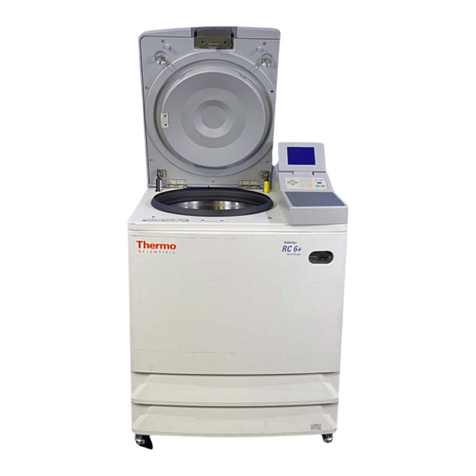
Thermo Scientific
Thermo Scientific Sorvall RC6 Plus instruction manual
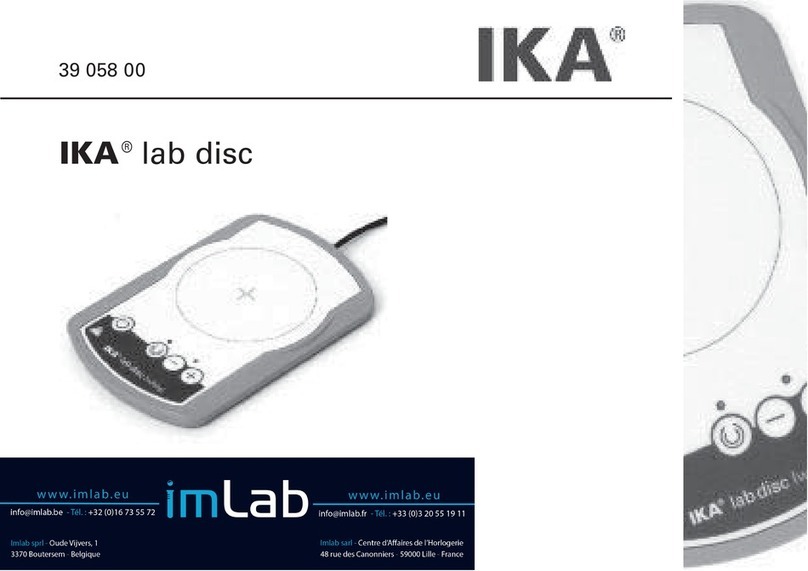
IKA
IKA Lab disc manual

Thermo Scientific
Thermo Scientific Sorvall Legend X1R instruction manual

Thermo Scientific
Thermo Scientific iCAP RQ ICP-MS Pre-installation requirements guide
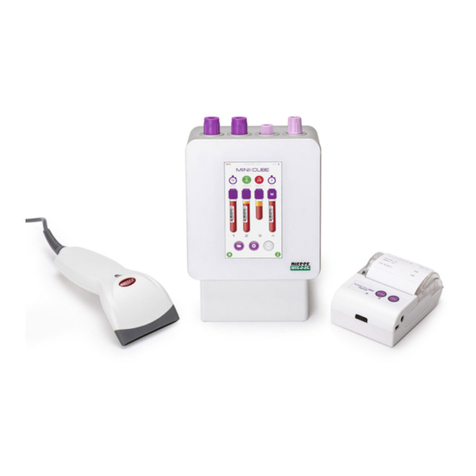
Diesse
Diesse MINI-CUBE user manual
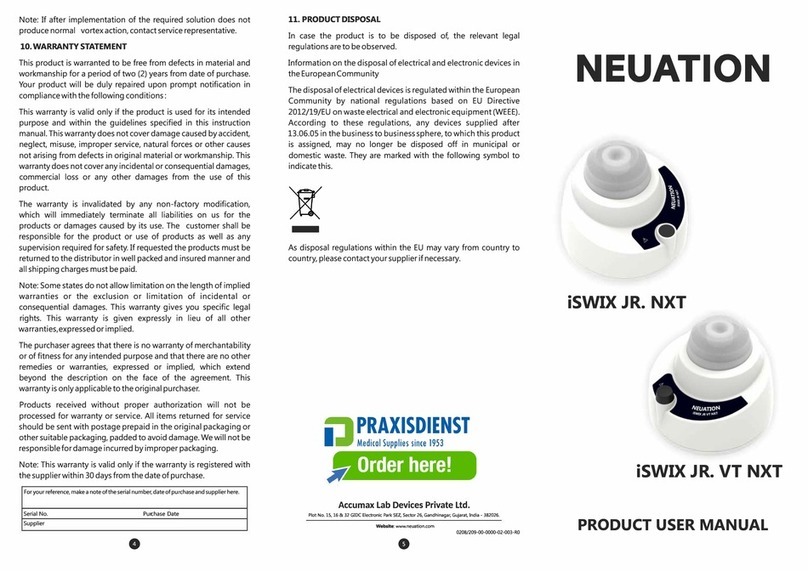
Neuation
Neuation iSWIX JR. NXT Product user manual
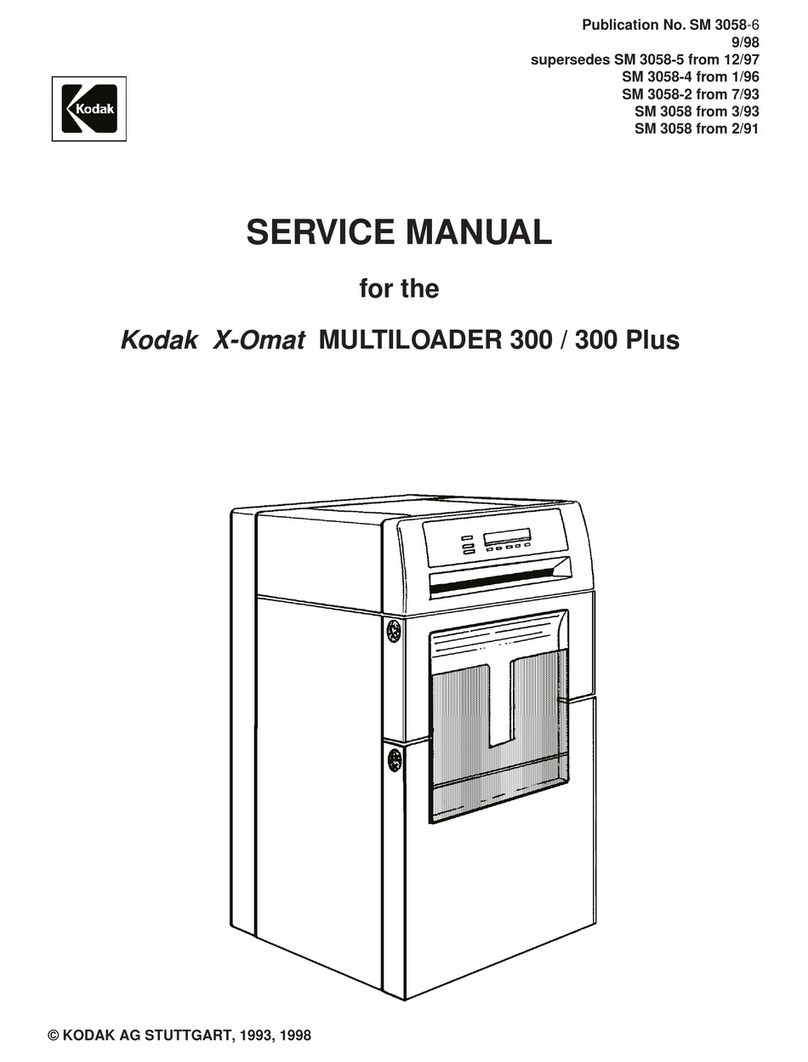
Kodak
Kodak X-Omat MULTILOADER 300 Plus Service manual
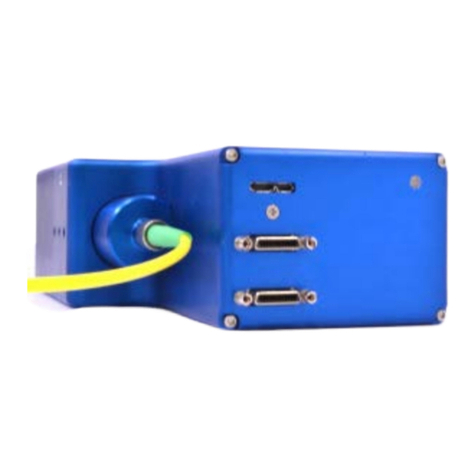
Wasatch Photonics
Wasatch Photonics Cobra OCT Getting started guide
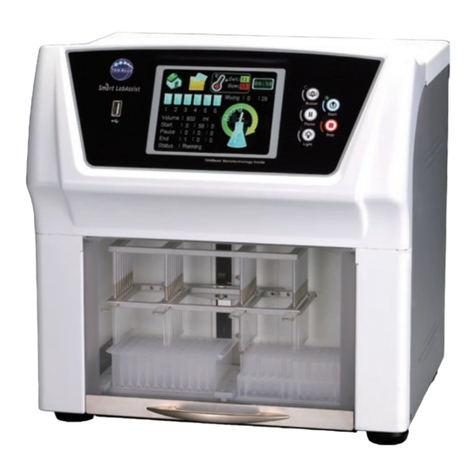
TAN Bead
TAN Bead Smart LabAssist Series user manual
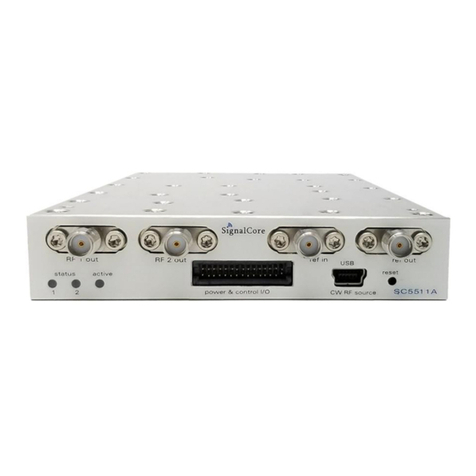
SIGNALCORE
SIGNALCORE SC5511A Operating & programming manual
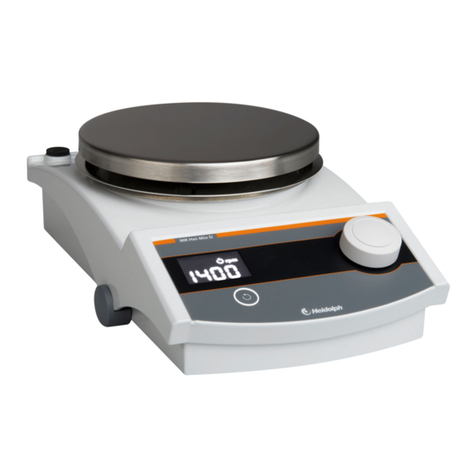
Heidolph
Heidolph MR Hei-Standard operating manual

ibidi
ibidi 11920 instruction manual
